 By
Mary Swift-Swan
By
Mary Swift-Swan
Jack’s Bistro is located in the
center of Jack London Square in Oakland, California, adjacent to the
Waterfront Plaza Hotel. Almost every table has a view of either the
Square or waterway activity. There is a patio for dining outside,
weather permitting. Diners are entertained most nights with music
from the piano bar. The glowing lights softly reflect the warm wall
colors and candlelight glints off table finery in the evening. When
we asked Chef Fabrice Foinel to share a signature dish, or a dish
that would be excellent for home cooks planning a romantic dinner,
his thoughts turned to the sea. For him, the sea is synonymous with
romance, and fresh fish is excellent brain food, which adds up to a
healthy mind full of romance—an attractive combination.
Good fish is fresh fish. It needs
to smell fresh to taste good. When there is fresh, firm-textured,
and flavorful Chilean Sea Bass available, Chef Fabrice treats his
customers to a dish that is topped with a special sauce that
combines the bounty of California and the art of his homeland, the
French Basque region where the mountains meet the sea.
|
Jack’s Grilled
Chilean Sea Bass with Monterey Meuniere Sauce
(for 2) |
|
2 6-8 oz pieces Chilean Sea Bass (about
1-inch thick)
2 medium Fresh artichokes, cooked
2 medium Roma tomatoes
4 oz Unsalted butter
1 oz Capers
2 whole Lemons (1 for juice, 1 for
serving wedges)
2 sprigs Parsley (1 chopped to fill a
soupspoon and 1 for accent)
1 tsp Aromatic golden virgin olive oil
Coarse salt and ground pepper to taste |
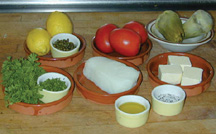 Prepare
Jasmine rice as a complementary base for the meal. Boil two pots of
water, one for rice and the other for artichokes. Gently warm the
plates. Trim away any artichoke stem that looks woody. Cook
artichokes in enough water so that they float but could be fully
submerged. Boil gently until a primary leaf can be pulled away from
the base with a gentle tug and the base is fork tender, but not
mushy (about 10 min). Drain and let cool. (They can be cooked a day
in advance.) When cool enough to touch, pull the edible leaves from
the artichoke and set aside. With a spoon, gently clean the fibrous
small leaves out of the artichoke bottom or heart. Dice the heart
into small pieces. When the artichoke is prepared, it is time to
start the entrée.
Prepare
Jasmine rice as a complementary base for the meal. Boil two pots of
water, one for rice and the other for artichokes. Gently warm the
plates. Trim away any artichoke stem that looks woody. Cook
artichokes in enough water so that they float but could be fully
submerged. Boil gently until a primary leaf can be pulled away from
the base with a gentle tug and the base is fork tender, but not
mushy (about 10 min). Drain and let cool. (They can be cooked a day
in advance.) When cool enough to touch, pull the edible leaves from
the artichoke and set aside. With a spoon, gently clean the fibrous
small leaves out of the artichoke bottom or heart. Dice the heart
into small pieces. When the artichoke is prepared, it is time to
start the entrée.
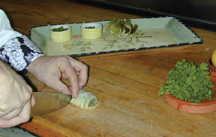 Turn
on the grill (or broiler) to medium high (375). Make sure there are
no bones in the sea bass filet. If there are, pull them out with a
pair of needle-nose pliers. Rinse and pat each filet dry with a
paper towel. Brush the sea bass with olive oil, using a paper towel
or pastry brush. Then dust both sides with a combination of salt and
pepper to taste. When the grill (or broiler pan) is hot, place the
thick fish steaks on the grill for about 10 minutes total. If
grilling, turn on each side twice to achieve criss-cross markings.
While cooking, prepare the other ingredients for the sauce.
Turn
on the grill (or broiler) to medium high (375). Make sure there are
no bones in the sea bass filet. If there are, pull them out with a
pair of needle-nose pliers. Rinse and pat each filet dry with a
paper towel. Brush the sea bass with olive oil, using a paper towel
or pastry brush. Then dust both sides with a combination of salt and
pepper to taste. When the grill (or broiler pan) is hot, place the
thick fish steaks on the grill for about 10 minutes total. If
grilling, turn on each side twice to achieve criss-cross markings.
While cooking, prepare the other ingredients for the sauce.
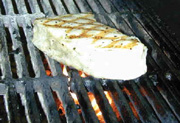 Cut
the roma tomatoes, clearing the outer shell (the object is to leave
the skin on). The soft center and seeds are not used in this dish.
Slice the meaty part of the tomato into narrow strips (julienne).
Cut
the roma tomatoes, clearing the outer shell (the object is to leave
the skin on). The soft center and seeds are not used in this dish.
Slice the meaty part of the tomato into narrow strips (julienne).
Prepare one lemon for its juice by
pressing down with an open hand and rolling the zesty fruit; then
cut it in half. Slice the other lemon into useful serving wedges.
Cut the parsley leaves away from one sprig and mince. Break up the
other sprig for garnish.
When the rice is ready, prepare a
cone of rice on each plate. Place edible artichoke leaves around the
cone forming a teepee around the rice. Arrange a fan of remaining
leaves, facing up like canoes around the outer plate edge placing 3
to 4 wedges of lemon onto the leaves. When the fish is ready, put it
on the open portion of the plate to rest.
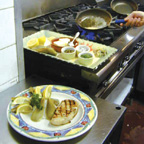 The
sauce only takes 2-3 minutes to cook. The fish will be perfectly
rested at the moment of serving. Start with a basic Meuniere by
melting the butter until it is a golden brown. Stop it from cooking
any further by adding the diced artichoke hearts and then the
capers, tossing to coat them in the butter. Next, add the tomatoes
and cook for one minute. Squeeze in the lemon juice and season with
a pinch of a mixture of salt and pepper. Finally, add parsley to
bind the ingredients and brighten the color.
The
sauce only takes 2-3 minutes to cook. The fish will be perfectly
rested at the moment of serving. Start with a basic Meuniere by
melting the butter until it is a golden brown. Stop it from cooking
any further by adding the diced artichoke hearts and then the
capers, tossing to coat them in the butter. Next, add the tomatoes
and cook for one minute. Squeeze in the lemon juice and season with
a pinch of a mixture of salt and pepper. Finally, add parsley to
bind the ingredients and brighten the color.
Give the entire sauce a toss, or
gentle stir, then pour evenly over the fish. It is important to
serve the dish immediately. Melted unsalted butter is a wonderful
complement for the texture and flavor of the fish, rice, and
artichokes. Be sure to serve the dish while the butter is still hot
so the fish and flavors remain light to the palate. Meuniere has
long been a personal favorite for artichokes. Adding artichokes to a
sauce for Grilled Sea Bass is a hint of Chef Fabrice’s inventive
flare combining the sumptuous style of France with the bounty of his
California home. Bon Appetite!!!
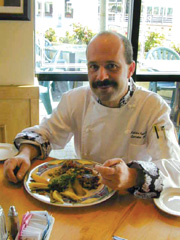 Chef
Fabrice Foinel is the Executive Chef at Jack’s Bistro and
consulting chef at the Durant and Park Plaza Hotels. Fabrice came to
the United States 13 years ago, and worked for several years at the
Washington Bash in San Francisco. After a short break to refocus,
his return to France was sidetracked when the Creative Hospitality
Corporation sought him out to help create a fine food Bistro on the
Oakland waterfront. Fortunately for all the diners who have had the
pleasure of eating at Jack’s, Fabrice was enticed to stay. He has
been executive chef at Jack’s for eight and half years.
Chef
Fabrice Foinel is the Executive Chef at Jack’s Bistro and
consulting chef at the Durant and Park Plaza Hotels. Fabrice came to
the United States 13 years ago, and worked for several years at the
Washington Bash in San Francisco. After a short break to refocus,
his return to France was sidetracked when the Creative Hospitality
Corporation sought him out to help create a fine food Bistro on the
Oakland waterfront. Fortunately for all the diners who have had the
pleasure of eating at Jack’s, Fabrice was enticed to stay. He has
been executive chef at Jack’s for eight and half years.
Often, executive chefs lament that
they don’t get the opportunity to cook as much as they like. Chef
Fabrice’s solution is to prepare Chef’s specials. This allows
him to cook creatively and to introduce new and unique dishes to his
customers. During his tenure, he has nurtured an appreciation and
demand for fine foods, so he knows that new dishes will be given a
good trial by the conservative yet educated palates of East Bay
diners. If his customers like a new dish, it is very likely to
appear on the ever-evolving menu.
Fabrice was born and raised in
Saint Jean de Luz, France, where the Pyrenees Mountains dive into
the Atlantic, considered the heart of the French Basque country.
Even as a 5-year-old child, he helped his Mom with the daily cooking
for the family of five. He said, "We never went out or ate junk
food. Why would we? Mom was a wonderful cook." Fabrice has
always loved to cook. At 11 or 12, he started helping in the family
restaurant. When company came, it was Fabrice and his Papa who
teamed up in the kitchen to cook together. Fabrice’s father became
a chef in Paris and then later a teacher. Fabrice smiles with a hint
of fond and proud memories when reminiscing about his training as a
chef in France, and shares that, "Yes, I studied in France, and
I was a student of my father." His father retired back to Saint
Jean de Luz. When we met, Fabrice had just returned from a brief
vacation to Saint Jean de Luz where he joined his retired father to
cook for a group of 400 concierges from the finest restaurants and
hotels from all over France. Fabrice was exhilarated by his
vacation, not exhausted. There is something very special about
cooking in the Foinels family